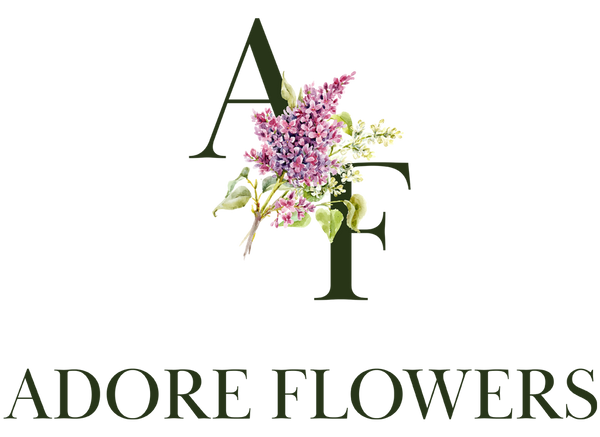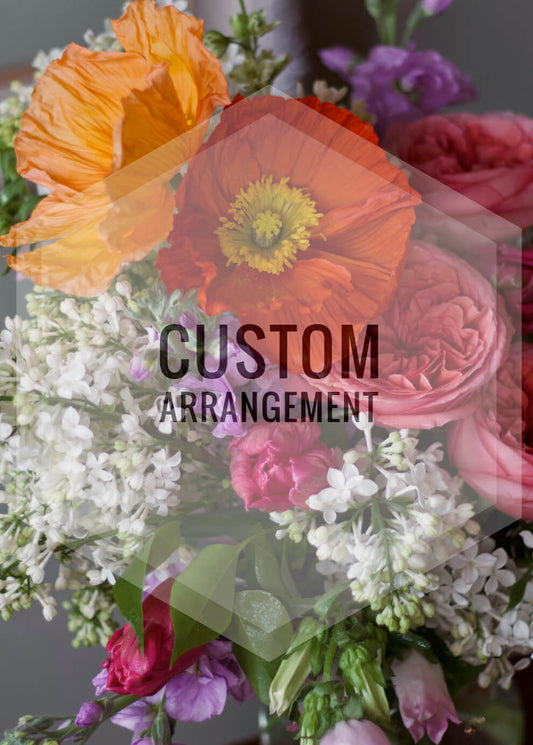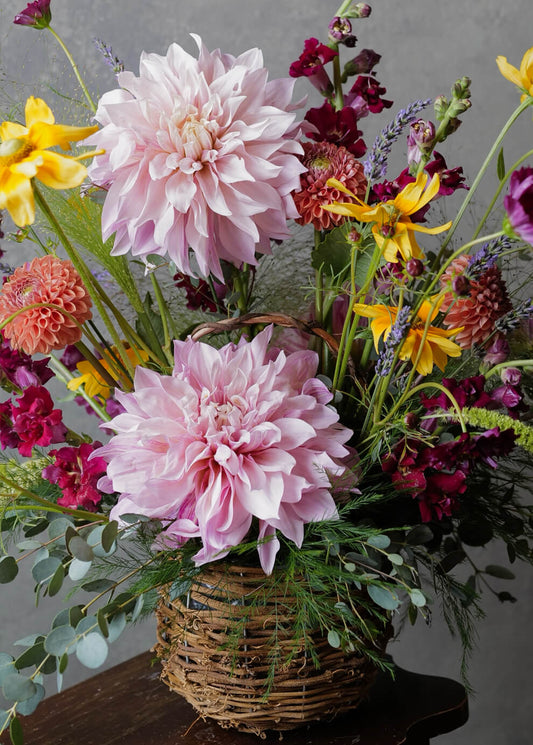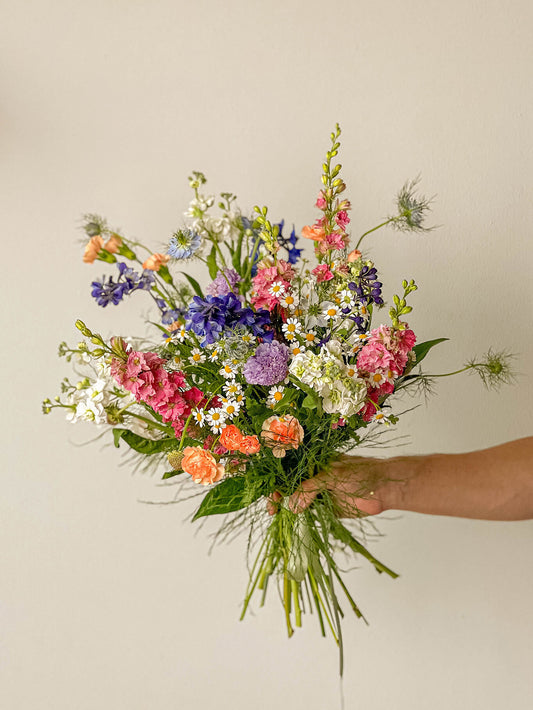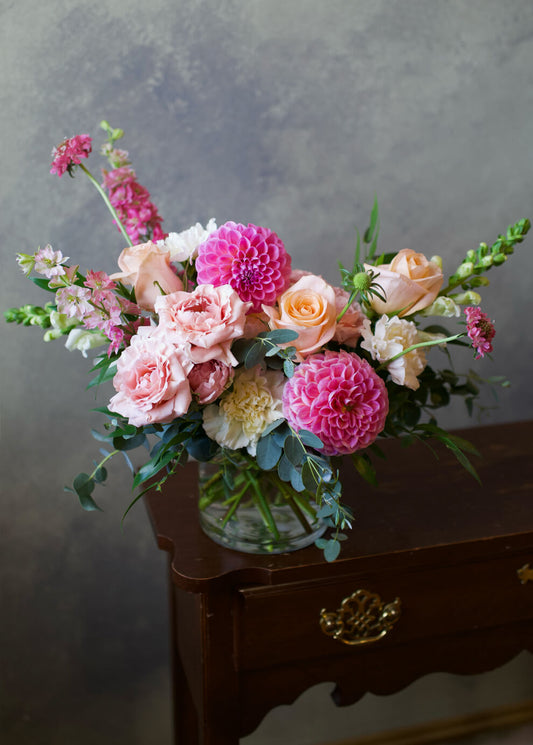I've been working with flowers in Philadelphia for years, and I've seen it all. Beautiful arrangements that totally transformed a space. Expensive bouquets that died in three days because someone put them next to a heater. Lilies that sent someone's cat to the emergency vet. Flowers shoved into apartments so dark they never stood a chance.
So let's talk about how to actually choose flowers for your home - the real advice based on what I've learned working with hundreds of clients, not the Pinterest fantasy version that looks pretty but doesn't work in real life.
If you’re looking for fresh flower delivery in Philadelphia, we can help you choose the right blooms for your home.
Before You Buy Any Flowers: Know Your Space
Here's what most guides won't tell you: the "right" flowers for your home have almost nothing to do with whether you have a modern minimalist aesthetic or rustic farmhouse vibes. That stuff matters a tiny bit for choosing colors and arrangement styles, but what REALLY matters is:
- How much light you actually have
- Whether you have pets
- How hot or cold your home is
- How much you're realistically willing to spend
- Whether you're going to remember to change the water
Let me break down each of these because they're way more important than matching your throw pillows.
The Light Situation (Especially Important in Philadelphia Rowhomes)
If you live in a Philadelphia rowhome, you know the struggle. These houses are beautiful, but a lot of them are dark. Windows on the front and back only, narrow layouts, not a ton of natural light in the middle rooms.
Here's the truth: some flowers absolutely need good light to survive in a vase. Without it, they'll droop, mold, or just look sad.
Flowers that NEED light to last:
- Roses - they need bright, cool light or they droop and get moldy
- Tulips - they stretch and twist toward light, getting floppy without it
- Gerbera Daisies - their heads collapse fast in shade or warm rooms
- Hydrangeas - super sensitive to heat and low light, heads collapse quickly
- Peonies - they want cooler, bright spots or their vase life drops dramatically
- Freesia - needs light for the buds to even open, otherwise half stay closed
Rule of thumb: If the flower has a big bloom or lots of layered petals, it probably wants light and cooler air.
Flowers that handle low light like champions:
- Chrysanthemums (mums) - seriously underrated, last forever
- Alstroemeria - tough as nails, can handle darker spots
- Carnations - yes, carnations, and I'll defend them in a minute
If your place is dark, stick with these. They'll actually survive and look good instead of dying in four days and making you feel like you wasted money.
The Pet Situation: Don't Mess Around With This
Let me be very clear: if you have a cat, lilies can kill them. Not "make them sick" - actually kill them. Even the pollen. Even if they just brush against the flower and then groom themselves. All lilies should be treated as toxic.
Other flowers to avoid with pets:
- Daffodils - toxic
- Tulips - toxic
- Hyacinths - toxic
- Amaryllis - toxic
- Azaleas - toxic
Here's the thing though: you CAN absolutely have fresh flowers with pets. The danger list is actually shorter than people think - it just happens to include some really popular flowers. The key is putting arrangements out of reach. High shelves, rooms the pet doesn't go in, areas they can't jump to.
Baby's breath? Toxic if eaten. Roses? Generally safe but the thorns are an issue. Carnations? Mild irritation if eaten but not deadly.
If you have a pet that likes to munch on everything they see, you need to be extra careful. In that case, put flowers where they physically cannot reach them, or honestly, maybe skip fresh flowers and go with non-toxic plants instead.
The Temperature Reality
Flowers hate heat. They just do. I've had clients put beautiful arrangements right next to heating vents or in direct sunlight streaming through a window, and then wonder why they died in two days.
Keep flowers away from:
- Direct sunlight (some diffused light is fine, but not blasting sun)
- Heating vents
- The top of appliances that give off heat
- Fireplaces (even when not in use, it's usually a warm spot)
Flowers last longest in cool rooms with some air circulation. At Adore Flowers, we keep them in fridges at 36-40 degrees. You obviously can't do that at home, but the closer to cool you can get, the longer they'll last.
Let's Talk About Money (The Real Numbers)
Here's what nobody wants to say: having fresh flowers from a florist in your home every week is expensive. Not "treat yourself" expensive - actually expensive as a regular habit.
If you're picking up arrangements from a florist in Philadelphia (not ordering delivery), you're looking at a minimum of $50+ per week for something decent-sized. That's $200+ per month. That's $2,400+ per year just on flowers.
Can you afford that? Great, do it. It's worth it if it makes you happy and fits your budget.
Can't afford that? Also totally fine. Here are your real options:
Budget Option 1: Trader Joe's They have a good selection of fresh flowers, usually $5-15 per bunch. Learn when they get deliveries (usually early in the week) and go then for the freshest stuff. Learn to pick fresh flowers - look for tight buds, firm stems, no brown edges.
Then learn to process them yourself: strip the lower leaves, cut the stems at an angle, put them in clean water with a drop of bleach. You can make grocery store flowers look way better with five minutes of effort.
Budget Option 2: Buy Once, Split It Up Get one nice arrangement from a florist and split it up around your house. Pull out a few stems and put them in small bud vases (or even clean hot sauce bottles - they work great). Put a couple stems in the bathroom, a few in the bedroom, and keep the main bunch in your living room.
This way one $50 arrangement becomes flowers in four rooms. The original arrangement won't look as full, but shuffle the remaining stems around so there's no big empty pocket.
Budget Option 3: Buy When You're In The Mood Don't force it. Buy flowers when you actually want them, not because you feel like you "should" have them. Once a month? Once every two months? Whenever you feel like treating yourself? All of these are fine.
Budget Option 4: Plants Get a few good plants instead. They last way longer than cut flowers, and some of them are basically impossible to kill. A potted plant is a one-time purchase that keeps going.
The Carnation Defense (Because Someone Has To Say It)
People hate on carnations. They think they're cheap, boring, funeral flowers. And yeah, there's some truth to that - culturally, many people associate red carnations with funerals. They're also inexpensive, which somehow makes people think they're not "good enough."
But here's what I've learned: carnations are beautiful, they last longer than almost any other flower, and they need very little care. They're one of the most resilient, long-living flowers you can buy.
The problem isn't carnations. The problem is how they're usually presented - in tight, boring grocery store bunches with nothing else.
Mix carnations with wildflowers or pair them with roses in a loose, airy arrangement? They look amazing. Use them in non-red colors - white, pink, burgundy, even green? People don't even recognize them as carnations, they just see a beautiful flower.
If you're on a budget and want flowers that actually last, carnations are your friend. Don't let flower snobbery stop you from using them.
Room-By-Room Reality Check
Most guides will tell you to put specific flowers in specific rooms based on vibes or whatever. Here's my actual advice from working with real homes:
Living Room: This is where you want your main arrangement. It's the room people see, where you spend time, where you want something that looks good. Go bigger here if you're going to splurge anywhere. Roses, peonies, anemones, or a mixed seasonal arrangement all work.
Kitchen: Small arrangements on the counter or table. Nothing huge because you need workspace. Herbs like rosemary or lavender are great here - they smell good and you can actually use them for cooking.
Bedroom: Be careful with scent. A huge arrangement of heavily scented flowers in a small bedroom is overwhelming. You'll wake up with a headache. If you do want flowers in your bedroom, go with lightly scented ones like tulips or ranunculus, and keep the arrangement small.
Better solution: take a couple stems from your main living room arrangement and put them in a small vase on your nightstand. Problem solved.
Bathroom: Orchids actually work great here because they like humidity. Eucalyptus branches near the shower smell amazing when the steam hits them. Keep it simple - one stem, maybe two.
Home Office: Low-maintenance is key. You're trying to work, not fuss with flowers. A small succulent or a peace lily (which also cleans the air) makes more sense than cut flowers.
Entryway: This is your first impression space. Something bold works here - tall stems, bright colors. Lilies or gladiolus look dramatic (but remember the pet toxicity issue with lilies).
The real rule though? Put flowers where YOU will see and enjoy them. If you never use your dining room, don't waste flowers there. If you spend all your time in your bedroom, put them there and ignore the "rules."
Matching Your Home Style (Or Not)
Yes, you can match flowers to your decor. Modern homes look good with clean, simple arrangements - maybe all white flowers, or a single type of flower in a sleek vase. Traditional homes pair well with classic roses and peonies in elegant vases. Rustic or eclectic spaces can handle wildflowers and loose, messy arrangements.
But honestly? I've seen yellow flowers pop beautifully against a dark wall in a way that had nothing to do with the "style" of the home. I've seen arrangements work just because the person loved the colors, even if they technically "clashed" with the decor.
The exposed brick that's common in Fishtown homes? It actually makes flowers look more rustic and helps colors pop. Dark walls can make bright flowers really stand out in a memorable way.
My advice: choose flowers in colors you like, in a style that feels like you. Your home style matters less than you think.
How to Actually Keep Flowers Alive (The Real Instructions)
Here's what works:
When you first get them:
- Cut about an inch off each stem at an angle. The angle matters because it increases the surface area for water absorption. Use sharp scissors.
- Strip off any leaves that would sit below the water line. Leaves in water = bacteria = dead flowers faster.
- Use clean water. Add the flower food packet if it came with one - it kills bacteria that blocks water absorption.
- If you don't have flower food, a tiny drop of bleach in the water does almost the same thing.
Every two days:
- Change the water completely. This is the most important thing. Bacteria builds up in flower water and blocks the stems.
- Check the stems. Trim off another half inch at an angle.
How to tell if flowers are actually dead vs. just thirsty:
Still alive:
- Stems feel firm and slightly springy when you squeeze them
- The base looks pale green or white
- Petals feel papery or limp but aren't discolored
- Leaves might look dull but still have some green
Dead:
- Stems are slimy, dark, or mushy at the bottom (bacteria took over)
- Petals are brown, see-through, or moldy
- Leaves are brittle or yellow all the way through
- Even cutting the stems won't help if the whole thing is soft
If you forget to change the water for five days: Cut the stems again and put them in fresh water. Some flowers will bounce back. Roses and alstroemeria are pretty forgiving. Hydrangeas? Probably dead. Try it and see.
Seasonal Flowers and Why They Matter
Buying seasonal flowers means they're fresher (they didn't have to travel as far) and usually cheaper. Here's what's actually in season:
Spring: Tulips, daffodils, hyacinths, ranunculus Summer: Roses, sunflowers, lilies, dahlias
Fall: Chrysanthemums, dahlias, marigolds Winter: Amaryllis, poinsettias, holly, evergreen branches
At Adore Flowers in Fishtown, we work with locally grown flowers whenever possible. They're fresher, they last longer, and you're supporting local growers instead of flowers that got flown in from another country.
The Artificial Flower Question
Look, I'm going to be honest: I don't love artificial flowers. They don't smell like anything, they don't have the natural beauty of real flowers, and if you don't dust them regularly, they look terrible. Nothing worse than dusty, greasy fake flowers.
BUT. They do add color. They don't die. They don't need water. And if you use them properly - in a corner that needs color, styled well, kept clean - they work well enough.
If you travel a lot, or you genuinely kill every plant you touch, or you have severe allergies, artificial flowers make sense. Just commit to dusting them every couple weeks.
Common Mistakes I've Seen (And How to Avoid Them)
Mistake 1: Getting flowers that last different amounts of time in one arrangement People ask for flowers that last a long time, but then also want to include flowers that wilt fast. We can do it, but you'll need to pull out the dead ones after a few days, which ruins the arrangement. Better to stick with flowers that have similar lifespans.
Mistake 2: Putting heavily scented flowers in bedrooms Big arrangement of lilies in a small bedroom = headache city. Split it up - a couple stems in the bedroom, the rest in the living room where air circulates more.
Mistake 3: Assuming expensive means it'll last longer Garden roses are expensive and beautiful, but they don't necessarily last longer than regular roses. Peonies are pricey and die relatively fast. Meanwhile, cheap carnations last two weeks. Price doesn't equal longevity.
Mistake 4: Never changing the water This is how you kill flowers fast. Bacteria builds up, blocks the stems, flowers can't drink. Change the water every two days minimum.
Mistake 5: Putting flowers in terrible locations Next to the heater. In direct sunlight. In a dark, hot room. Flowers need cool air and some light. Location matters more than the type of vase you use.
Working With a Local Philadelphia Florist
Here's why buying from a real florist in Philadelphia matters: we know which flowers are fresh, we process them properly, we can give you actual advice about what will work in your space, and we can customize arrangements based on what you need.
At Adore Flowers, we're a pickup and delivery-only studio in Fishtown. Every arrangement is made specifically for you, with European-inspired designs that are airy and natural rather than tight and generic. We focus on quality over mass production, and we use locally grown flowers whenever possible.
Call us at (267) 275-6460 or visit www.adore-flowers.com. We'll help you figure out what actually works for your home, your budget, and your lifestyle - not just what looks good on Instagram.
The Bottom Line
Choosing flowers for your home isn't complicated, but it is more practical than most guides make it sound. Light matters. Temperature matters. Pets matter. Budget matters. Whether you'll actually change the water matters.
Start with one arrangement in your main living space. See how it goes. Learn what works in your home - what lasts, what you enjoy, what's worth the money. Then adjust from there.
And seriously, don't sleep on carnations. They're trying their best.
Visit your local florist in Fishtown or wherever you are in Philadelphia. Get real advice from people who work with flowers every day. Your home will look better, your flowers will last longer, and you won't waste money on arrangements that die in three days because nobody told you not to put them next to the heater.
Fresh flowers can absolutely transform your space. You just need to be realistic about what will actually work in your real life, not someone else's carefully staged photos.
